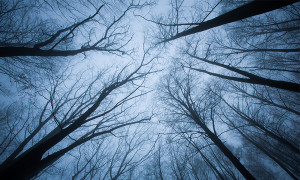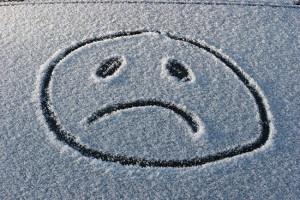When introducing myself to people and telling them that I am from Los Angeles, I always get asked the same two questions a large percentage of the time; “why did I come here?, and am I ready for the winter?” After getting asked that questions so many times and hearing repeatedly how I am “going to die” during the winter, or maybe even the fall due to the unfamiliar drop in temperatures. I began to think about how sick I will probably get of the cold and snow, and how I will desperately miss my 60 degree winters. While thinking about this I started to actually get a little homesick and sad which led me to further researching whether or not weather depression is actually a real illness. Seasonal Affective Disorder, is ironically known by its more common acronym “SAD”. Which “According to Dr. Joseph V. Pace, Chief of Psychiatry at the Alaska VA Medical Center, SAD is defined as “recurring depression with seasonal onset and remission.” (Hans) Dr. Pace details how in places where it is dark for a good portion of the year, for instance, where he resides in Alaska, that their lack of sun can have a negative effect on one’s mood; “low vitamin D levels…can correlate with depression”.
Some have nicknamed this form of depression with the term “Winter Blues”, disvalued by Dr. Pace in his article, there are many symptoms that can be attributed to this “mood disorder” (Hans) such as; “increased appetite, weight gain, sleep loss, decreased energy and lack of motivation” (Hans). The cold weather invites one to not leave their comfortable, warm, and often solitude surroundings, which lulls them into a depressed state of hibernation for the winter. Coming here from California, I wondered if my lack of winter tolerance would hinder me in obvious ways such as leaving me freezing when it was 50 degrees outside when everyone else was contemplating wearing a short sleeve shirt. However, I never thought about how it would detract from my want to go out and see my friends, go to class, and opt to eat the easy mac in my room rather than venture to the commons for a salad. The more and more I began to think about my life come winter and research what provokes Seasonal Affective Disorder, began to wonder that if the areas of the U.S. that were hit hardest during the winter had a significant amount of the population plagued by this disorder.
In an article written for boundless.com, it is stated that “Although experts were initially skeptical, this condition is now recognized as a common disorder, with its prevalence in the U.S. ranging from 1.4 percent in Florida to 9.7 percent in New Hampshire” (Boundless). The lack of “natural light” that one is exposed to on the east versus the west coast, is substantially less due to the fact that where I am from in Southern California, it is typically 75 degrees and sunny for majority of the year, whereas here in State College the season of winter engulfs the area for a many months. In addition to looking at the differences between the extensiveness of SAD in more sunny and dreary places, I looked at how my findings correlated with suicide rates in places severely impacted by winter. CBS news created a list of the “Top 10 states with the highest and lowest suicide rates”(CBS News), and after looking at the list, I found a correlation between states with the highest suicide rates having some of the worst winters. For example, in addition to being the largest state, Alaska, has one of the highest suicide rates in the country. “In 2007, for every 100,000 Alaskans, 21.8 died by suicide”(CBS News). With 6 months of darkness per year, Alaska is a state that perfectly exemplifies the conditions in which one would begin to suffer from SAD.
For those suffering from this mood disorder, there are many ways in which one can get back to feeling normal. For instance, New York Times journalist Richard A. Friedman M.D. cited Dr. Rosenthal’s; “a professor of clinical psychiatry at the Georgetown Medical School”(citation); findings in his book “Winter Blues”(Friedman) to acknowledge that “Light is a nutrient of sorts for these patients”(Friedman). Having bright and/or natural light exposure early in the day can work to cure patients. In addition to light therapy, other additional treatments include melatonin sentiments and antidepressants. Overall, Seasonal Affective Disorder is a serious mood disorder that has side effects ranging from weight gain to suicide. Thus, through my research I think that “winter depression” is truly a serious issue harming many people.
Works Cited:
Boundless. “Seasonal Affective Disorder and Jet Lag.” Boundless Anatomy and Physiology. Boundless, 21 Jul. 2015. Web. 5 Sep. 2015 <https://www.boundless.com/physiology/textbooks/boundless-anatomy-and-physiology-textbook/the-endocrine-system-16/endocrine-system-diseases-disorders-and-clinical-cases-163/seasonal-affective-disorder-and-jet-lag-817-8611/ >
Friedman, Richard. “Brought on by Darkness, Disorder Needs Light.”The New York Times. The New York Times, 18 Dec. 2007. Web. 5 Sept. 2015.<http://www.nytimes.com/2007/12/18/health/18mind.html?_r=0>
Petersen, Hans. “Mental Health.” Mentalhealth.va.gov. 25 Jan. 2011. Web. 5 Sept. 2015. <http://www.mentalhealth.va.gov/featurearticle_jan25sad.asp >
“20 States With the Highest Suicide Rates.” CBSNews. CBS Interactive. Web. 5 Sept. 2015. <http://www.cbsnews.com/pictures/suicide-20-states-with-highest-rates/22/ >



Coming from Wallingford, Pennsylvania, which is located in Delaware County, the weather up here in State College is very comparable to that in my hometown. For me, there is no shock for the weather that is to come, for I have gone through it every winter that I have been alive. Though I am still active throughout the winter, I can understand the reasons behind this disorder. As WebMD states, http://www.webmd.com/depression/features/seasonal-affective-disorder , this disorder is caused by lack of light. In 2011, I went on a trip to Alaska in August. There many stressed to us how they have an increasing rate of suicide based off of the amount of light per day there. To me, I can see how this may not only be a correlation, but rather it could be causation too. At home, though we are still active in the winter, we still do less, and for less time. To me this lack of exposure to the light makes sense, and I can see how SAD is a serious condition.
For starters, I am very jealous that you have 60 degree winters. Being from New York, and experiencing some of the most brutal winters known to man, I have learned to have to love winter. There are times when I am noticeably upset in the winter because of the impact that the weather has on my mood. If I am in a bad mood due to something else going on, the weather does not help the situation. What I try to do is fill my room with bright lights and a lot of natural sunlight to avoid dull lighting and no sunlight. I am one that loves to be outside in the summer, and inside in the winter. Maybe it is time that I get outside during the winter and embrace the little bit of sun that State College gets during the cold and dreary winter months. Interesting blog post, thanks for sharing!
It is interesting to see that colder weather is correlated to higher suicide rates. But I wonder if warmer weather in different countries will differ from the suicide rate. Will countries near Equator have lower suicide rates than countries near Antarctica or Arctic? Do they have confounding variables that affect the result? I think I have the same situation “mood disorder” as you have written in your research because I increase my appetite, gain weight, sleep less, and have decreased energy and lack of motivation to work when the temperature become lower but I think there are other factors influencing. We need more energy in winter to keep us warm. I work out less in winter than in summer but I do not feel more depressed in winter. So maybe more research on finding out if there are third variables influencing depression and cold weather.
My mom during the winter always tells me to go outside to get Vitamin D because the “Winter Blues” is a real thing. Coming from Connecticut, the whether at PSU is no shock to me. Because of this I also know that this seasonal depression is a very real thing. Almost everyone I know exhibits some form of it. One of the things I liked about your blog is that fact that you gave solutions to the “Winter Blues.”
Coincidentally, I just wrote a blog about SAD due to the fact that I am also from Los Angeles. Going back for Thanksgiving break to warmth then coming back to Penn State was definitely a shock. I believe that for myself it is the sun or lack of it that has a greater affect on me rather than the temperature. Vitamin D plays an important role in this in that a lack of this vitamin can cause depression; most people receive this vitamin from natural sunlight. https://www.vitamindcouncil.org/health-conditions/depression/. There are brain receptors that are connected with vitamin D and lack of it can cause mental disorders or depression. So going to a cold school when one is use to all year round sunlight should be cautious and aware that something like SAD disorder is very much a real thing.
Amanda after reading this I looked further into the relation between light deprivation and depression. The article I found conducted an experiment where they kept rats in the dark for 6 weeks. These rats exhibited signs of depression and also brain damage in the same region that is effected when humans experience depression. I always thought that the depression symptoms stemming from seasons were due to temperature change, like you talked about in your opening paragraph. But seeing as the days are a lot shorter in the winter, it seems the depression stems from an over exposure to darkness.
Here is the link to the article I read: http://www.scientificamerican.com/article/down-in-the-dark/